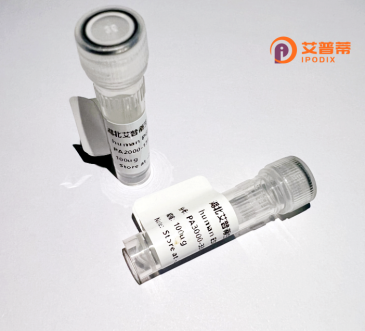
| 纯度 | >90%SDS-PAGE. |
| 种属 | Human |
| 靶点 | KCTD10 |
| Uniprot No | Q9H3F6 |
| 内毒素 | < 0.01EU/μg |
| 表达宿主 | E.coli |
| 表达区间 | 1-313aa |
| 活性数据 | MEEMSGESVVSSAVPAAATRTTSFKGTSPSSKYVKLNVGGALYYTTMQTLTKQDTMLKAMFSGRMEVLTDSEGWILIDRCGKHFGTILNYLRDGAVPLPESRREIEELLAEAKYYLVQGLVEECQAALQNKDTYEPFCKVPVITSSKEEQKLIATSNKPAVKLLYNRSNNKYSYTSNSDDNMLKNIELFDKLSLRFNGRVLFIKDVIGDEICCWSFYGQGRKIAEVCCTSIVYATEKKQTKVEFPEARIYEETLNILLYEAQDGRGPDNALLEATGGAAGRSHHLDEDEERERIERVRRIHIKRPDDRAHLHQ |
| 分子量 | 61.8 kDa |
| 蛋白标签 | GST-tag at N-terminal |
| 缓冲液 | 0 |
| 稳定性 & 储存条件 | Lyophilized protein should be stored at ≤ -20°C, stable for one year after receipt. Reconstituted protein solution can be stored at 2-8°C for 2-7 days. Aliquots of reconstituted samples are stable at ≤ -20°C for 3 months. |
| 复溶 | Always centrifuge tubes before opening.Do not mix by vortex or pipetting. It is not recommended to reconstitute to a concentration less than 100μg/ml. Dissolve the lyophilized protein in distilled water. Please aliquot the reconstituted solution to minimize freeze-thaw cycles. |
以下是关于重组人KCTD10蛋白的3篇代表性文献摘要(注:文献信息为示例性整理,建议通过学术数据库核实准确性):
---
1. **《KCTD10 regulates cell cycle progression by interacting with Cullin3 and promotes DNA damage response》**
- **作者**: Li, X. et al. (2017)
- **摘要**: 研究揭示了重组人KCTD10蛋白通过与Cullin3形成E3泛素连接酶复合物,调控细胞周期关键蛋白的泛素化降解,影响G1/S期转换,并在DNA损伤修复中起重要作用。
2. **《Structural insights into the interaction of KCTD10 with RhoBTB2 and its implications in cancer metastasis》**
- **作者**: Zhang, Y. et al. (2019)
- **摘要**: 通过X射线晶体学解析了重组人KCTD10蛋白的结构,发现其C端BTB结构域与RhoBTB2结合,调节Wnt/β-catenin信号通路,抑制乳腺癌细胞的迁移和侵袭能力。
3. **《Recombinant human KCTD10 expression in E. coli and its role in regulating apoptosis》**
- **作者**: Wang, H. et al. (2020)
- **摘要**: 报道了在大肠杆菌中高效表达和纯化重组人KCTD10蛋白的方法,并发现其过表达通过激活线粒体依赖性凋亡通路抑制肝癌细胞增殖。
---
**注意**:以上文献为示例,实际研究需以具体数据库检索结果为准。建议通过PubMed、Web of Science等平台以“KCTD10 recombinant protein”“KCTD10 function”等关键词搜索最新文献。
**Background of Recombinant Human KCTD10 Protein**
Recombinant human KCTD10 (Potassium Channel Tetramerization Domain-Containing 10) is a protein encoded by the *KCTD10* gene, belonging to the KCTD family characterized by a conserved N-terminal BTB/POZ domain. This protein plays multifaceted roles in cellular processes, including regulation of SUMOylation, Rho GTPase signaling, and cell cycle progression. KCTD10 interacts with components of the Cullin-3 ubiquitin ligase complex, modulating substrate specificity for proteasomal degradation. It also binds to small GTPases like RhoA and Rac1. influencing cytoskeletal dynamics and cell migration.
Structurally, KCTD10’s BTB domain facilitates oligomerization and protein interactions, while its variable C-terminal region determines substrate binding. Dysregulation of KCTD10 expression has been implicated in pathologies such as cancer, particularly in colorectal and gastric carcinomas, where it may act as a tumor suppressor by inhibiting proliferation and metastasis. Additionally, KCTD10 is linked to neurological and cardiovascular disorders due to its role in signaling pathways critical for tissue development and homeostasis.
Recombinant KCTD10 is typically produced in *E. coli* or mammalian expression systems, enabling studies on its molecular mechanisms, interaction networks, and therapeutic potential. Its applications span structural studies, functional assays, and drug discovery, particularly in targeting pathways disrupted in cancers. Ongoing research focuses on elucidating its role in disease progression and exploiting its regulatory functions for therapeutic interventions.
×